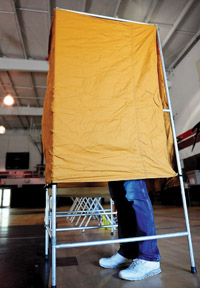While a potential general sales tax measure could bring in more than $5 million to the county annually if approved by local voters, San Benito County supervisors opted to take the discussion to an upcoming intergovernmental meeting to seek input from officials in Hollister and San Juan Bautista before deciding how to proceed.
Janelle Cox, a management analyst for San Benito County, presented information to supervisors with hopes of getting direction on how much of a tax increase they want to pursue and when they want to pursue it. Cox said the state’s Board of Equalization said it could levy just a general sales tax measure across the entire county, including both unincorporated areas as well as the cities of Hollister and San Juan Bautista.
Counties are allowed to levy up to 2 percent above the state sales tax rate in special taxes, including any special taxes collected in the cities. With the city of Hollister collecting a 1 percent tax, the maximum the county could levy would be 1 percent.
The maximum increase would bring the county’s sales tax rate from 7.5 percent to 8.5 percent, while Hollister’s would be 9.5 percent and San Juan’s would be 9.25 percent.
Cox said the Board of Equalization explained an option that would not increase the tax rate in the incorporated cities. The cities would have to rescind their own sales tax and sign tax-sharing agreements contingent on the county’s general sales tax measure being approved. Based on sales tax collected in the first quarter of 2013, Cox said the county’s share of a 1 percent increase would be $1.4 million, with $3.45 million going to Hollister and $150,000 to San Juan – the figures would go up or down depending on sales.
County officials had originally looked at pursuing a special tax district to support parks, recreation and libraries. A report based on community surveys found there was not enough support among likely voters to meet the two-thirds voter approval needed for a special district, but found there was enough approval of a special tax district to meet the threshold for a general sales tax that requires just a majority voter approval. Unlike a special tax district, the use of a general sales tax is at the discretion of supervisors.
Supervisor Jerry Muenzer suggested supervisors talk with city officials before moving forward.
“This needs to go back to the intergovernmental meeting to see what the city of Hollister and San Juan feel before we go forward,” Muenzer said.
Supervisor Robert Rivas said he would have wanted to see numbers related just to collecting a general sales tax measure in the unincorporated county areas, noting that he believed Santa Clara County had passed a general sales tax measure in its unincorporated areas. Cox said the Board of Equalization was very clear that the county general sales tax would need to span the entire county, but she said she would research that option. County counsel Matthew Granger said he also spoke with BOE officials who said a general sales tax would need to include the incorporated cities and unincorporated areas.
According to a press release from the BOE, a 0.125 percent sales tax increase was approved in Santa Clara County in 2012, but it included unincorporated and incorporated cities.
“I think we should explore the opportunity in the unincorporated area,” Rivas said. “It could be a good thing in the future.”
He said he was concerned about moving forward “because of trust issues.”
He said the current board couldn’t be sure how future supervisors or administrators would allocate funds from a general sales tax.
Supervisor Margie Barrios said she would want some of the money to go to libraries, parks and recreation. She inquired with Joe Paul Gonzalez, the county’s elections official, about state legislation that has been proposed that could amend the threshold for voters to approve a special tax districts from a two-thirds majority to 55 percent.
“Would it behoove us to wait and see where the state amendments go?” she asked.
Gonzalez said the amendment holds a lot of unknowns and waiting may put the city behind schedule to move forward with a 2014 ballot measure.
Cox said she thought the time to meet with the cities at an intergovernmental meeting would put the process behind schedule by two months. She said by the time a consultant is hired to do outreach, they would likely not be able to start a survey of the community until January, leaving a tight timeline to decide whether supervisors want to move forward with a ballot measure for 2014. They would need to begin work on an ordinance no later than May for the November 2014 gubernatorial election.
County staff also discussed the possibility of holding off on a ballot measure until 2016.
“For a sales tax measure to be successful, most say take it to the voters during a high-voter turnout such as a general presidential election,” Gonzalez said.
Supervisor Jaime De La Cruz said he would want to see some money going into what he called “older town Hollister,” referring to the west side of the city.
“We need to look at where we need it,” De La Cruz said, of the infrastructure in his district. “The city of Hollister used to have RDA, but the RDA does not exist anymore and every day it’s getting worse.”
Supervisors directed staff to look into the sales tax measure in Santa Clara County and to aid the general sales tax measure to the next agenda for the intergovernmental committee.










